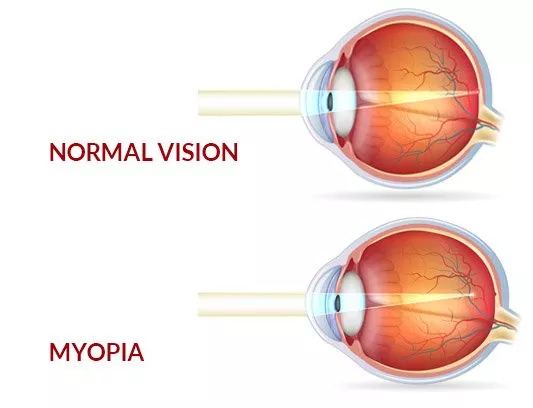Nearsightedness is also known as myopia. Myopia take place when the eyeball become longer than the original size or when cornea is become sharp than median. In Myopia light is focus in front of the retina instead of directly on the surface.
People with nearsightedness may blink their eyes when trying to see object in the distance. While reading they may bring books very close to their eyes or may sit near to television to watch anything.
Nearsightedness need visual correction in the form of contact lenses or eye glasses. Nearsightedness can also be corrected by refractive surgery called Lasik.
Causes Of Myopia

No one knows the causes of myopia. Genetics plays an important role. People who are involved in doing more near work has long history in association of increase in nearsightedness.
Scientists also showed that peoples with higher education that included a lot of near work were less prone to nearsighted than those who are highly educated or work which requires near vision.
Most of us are unprotected to an excessive amount of near stimuli with computers, tablets, mobile phone devices. The jury is still confused that whether this is really the fact we as a society need to be concerned about or not.
Some studies shows that near work does not cause myopia and some shows that it does. It is probably a hard algorithm that contain genetics and the quantity of time spend outdoors.
Environment play an important role. There is proof that shows that time spend outdoors seems to have a protective effect. Children who spend much more time outdoors are much less likely to be nearsighted.
How To Prevent Myopia?
Doctors encourage the idea that if the development of myopia can be cut to 50% so the incidence of serious problem can also be cut by a notable amount. Some ways to prevent myopia Here are.
Visual Correction
Many people are concerned that if a doctor prescribe glasses to their children so they will become dependent on them or that the glasses themselves will cause more nearsightedness to occur and feel that it is best to not correct the condition at all.
But it is showed by research that not correcting a child myopia could actually cause the myopia to worsen. More, under-correcting myopia was once thought to have an impact on reducing the progression. But current thought is that under-correction is associated with a higher rate of nearsightedness progression.
Outdoor Activities
Studies show that outdoor time can reduce the progression of nearsightedness. The amount of time spent outside appears to at least be an important risk factor is still under observation.
Multifocal Contact Lenses
Children wearing soft multifocal lenses had 25% less myopia progression and 31% less axial elongation than those wearing single-vision lenses.
The center-distance multifocals focus light in front of the peripheral retina and they focus light right on the central retina, which provides people with clear vision.
Orthokeratology
It is also known as corneal refractive therapy, corneal reshaping and gentle corneal molding is a procedure in which special corneal molds is analogous to rigid gas permeable lenses and they are fit and slept in overnight.
Reverse-geometry lenses are the lenses used. Cornea is flatten centrally but peripherally steepen, causing a shape change in the cornea that lessens the peripheral hyperopic defocus and make nearsightdness defocus which can slow the progress of myopia.
Read more interesting article on lustereyes.
Leave a Comment